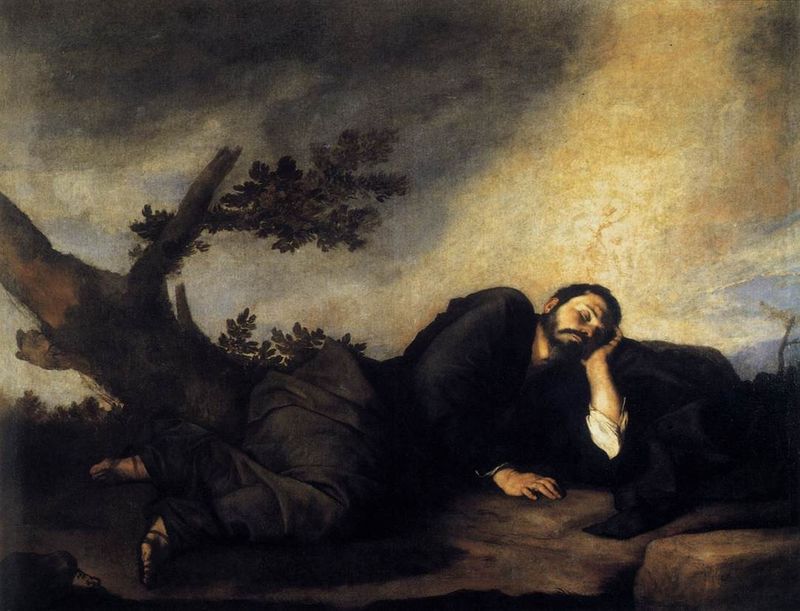
by Fr. Patrick Henry Reardon
According to the Bible, the true founder of the shrine at Bethel was Jacob. Genesis describes the prompting occasion:
“Now Jacob went out from Beersheba and went toward Haran. So he prayed in a place and stayed there all night, because the sun had set. And he took one of the stones of that place and put it at his head, and he lay down in that place to sleep. Then he dreamed, and behold, a ladder set up on the earth, and its top reached to heaven; and the angels of God were ascending and descending on it.”
In the course of the dream Jacob received specific promises of God relative to his own life and to the ongoing drama of Salvation History. On awakening, he found himself still deeply moved by the experience:
“‘Surely, the Lord is in this place, though I was unaware.’ And he was afraid and said, ‘How terrifying is this place! This is none other than the house of God, and this is the gate of heaven!'”
Then, by way of consecrating the site, Jacob
“took the stone that he had put at his head, set it up as a pillar, and poured oil on top of it. And he called the name of that place ‘House of God’ (Beth-El)” (Genesis 28:10-18).
This modest consecration was the beginning of Israel’s traditional shrine at Bethel.
My translation of vayiphg’a-–as “and he prayed”—in Genesis 28:11 follows the lead of Rabbi Solomon ben Isaac, or Rashi (died 1105), who records the interpretation “of our rabbis” (rabotenu) that vayiphg’a was understood to replace the word “intercession” (tephillah). The authentic meaning of this verse, according to Rashi, is that Jacob “prayed in this place” before he lay down to sleep. The vision in his dream, therefore, was God’s response to Jacob’s prayer. “Thus,” wrote Rashi,
“we learn that he inaugurated prayer at evening”—velimdanu shattiqqan tephillat ‘erbit.
This prayer at eventide was later given a solemn form in the ritual of the Temple: the daily evening sacrifice. This ritual, in turn, became Vespers in the diurnal of Holy Church. To this day we Orthodox Christians employ the identical psalmody of the Temple’s daily evening sacrifice as an integral part of Vespers. The history of this service warrants our speaking of Jacob as the initiator of the discipline of daily Vespers.
The Church’s first “Theologian” portrayed the prophetic force of the Bethel event in his description of the calling of Nathaniel:
Jesus saw Nathanael coming toward him, and said of him,
“Behold, an Israelite indeed, in whom is no guile!” Nathanael said to him, “How is it you know me?” Jesus answered and said to him, “Before Philip called you, when you were under the fig tree, I saw you.” Nathanael answered and said to Him, “Rabbi, You are the Son of God! You are the King of Israel!” Jesus answered and said to him, “Do you believe because I said to you, ‘I saw you under the fig tree?’ You will see greater things than these.” And he said to him, “Amen, I say to you, you shall see heaven open, and the angels of God ascending and descending upon the Son of Man” (John 1:47-51).
The allusion to the Bethel revelation—Jesus himself as the ladder of Jacob’s dream—continues John’s theme of the incarnate Word’s dwelling among us (cf. 1:14). Jesus is here identified as the true shrine, the tabernacle (or temple—cf. 2:19-21) of the Word among men.
Saint Augustine of Hippo revels in the rich imagery of the scene:
“Who is the stone placed under Jacob’s head but Christ, the head of man? And in its anointing the very name of Christ is expressed, for, as all know, Christ means ‘anointed.’”
In making this identification, Augustine is aware of following the thought of the first chapter of John. He continues:
“Christ refers to this in the Gospel, and declares it to be a type of himself, when he said of Nathanael that he was an Israelite indeed, in whom was no guile, and when Nathanael, resting his head, as it were, on this Stone, or on Christ, confessed him as the Son of God and the King of Israel, anointing the Stone by his confession, in which he acknowledged Jesus to be Christ. On this occasion the Lord made appropriate mention of what Jacob saw in his dream ‘Amen, I say unto you, You shall see heaven opened, and the angels of God ascending and descending on the Son of Man’” (Against Faustus 15.26).
The stone, then, was a typos of Christ, the true locus where earth and heaven are joined. Christ is the mediating ladder of the Church’s prayer, an important part of which we trace to Jacob.
